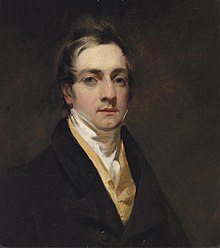Peter Van Brugh Livingston
Peter Van Brugh Livingston | |
|---|---|
 | |
| New York State Treasurer | |
| In office 1776–1778 | |
| Preceded by | Office created |
| Succeeded by | Gerard Bancker |
| Personal details | |
| Born | November 3, 1710 Elizabethtown, New Jersey, U.S. |
| Spouses | Mary Alexander
(m. 1739; died 1767)Elizabeth Ricketts (m. 1771) |
| Children | 12 |
| Parent(s) | Philip Livingston Catharine Van Brugh |
| Relatives | See Livingston family |
| Alma mater | Yale College |
Peter Van Brugh Livingston (bp. November 3, 1710
Early life
Peter Van Brugh Livingston was the second surviving son of
Livingston's mother was the only child of his namesake, Pieter Van Brugh (1666–1740), the Mayor of Albany, New York from 1699 to 1700 and from 1721 to 1723.[4] His grandfather's sister, Catharina Van Brugh, married Hendrick van Rensselaer, the son of Jeremias van Rensselaer, patroon of Rensselaerswyck.[5] Livingston's maternal great-grandfather, Johannes Pieterse van Brugh (1624–1697), was one of the early settlers of New Netherland and was prominently connected with the Dutch West India Company.[6]
His paternal grandparents were Alida Schuyler (1656–1727) and Robert Livingston the Elder (1654–1728), and his uncle was Robert Livingston (1688–1775) of Clermont.[2]
Career
After his graduation from Yale, he became engaged in the shipping business with
In 1748, he helped found the College of New Jersey (now
In 1775, he was a member of the Committee of One Hundred. He was a delegate to the New York Provincial Congresses, and was President from May 1775 to August 1775 and from September 1776 to March 1777.[10] He was also Chairman of the Committee of Safety from September 1776 to March 1777.[1] In 1776, he was appointed Treasurer by the Provincial Congress, and remained in office until 1778, after the establishment of the State Government.[2][11]
Personal life
His home in New York City was a large mansion on the east side of what is now
On November 3, 1739, Peter Van Brugh Livingston married Mary Alexander (1721–1767), the daughter of James Alexander and Mary Spratt Provoost, and the sister of his business associate, Lord Stirling. Before her death in 1767, they had twelve children, including:[2]
- Philip Peter Livingston (1740–1810), who was known as "Gentleman Phil," and who married Cornelia Van Horne (b. 1759).[12]
- Mary Livingston (1742), who died in infancy.[2]
- Catherine Livingston (1743–1775), who married Nicholas Bayard.[2]
- James Alexander Livingston (b. 1744).[2]
- Mary Livingston (1746–1780),[13] who married Capt. John Brown.[2]
- Peter Livingston (b. 1753), who married Susan Blondel.[2]
- Sarah Livingston (1755–1825), who married Capt. James Ricketts.[2]
- William Alexander Livingston (1757–1780), who was killed in a duel.[2]
- Susan Livingston (1759–1853), who married (1)
- Elizabeth Livingston (1761–1787), who married French consul Monsieur Otto.[2]
- James Alexander Livingston (b. 1763), who died young.[2]
- Ann Livingston (b. 1767), who died young.[2]
On April 9, 1771, he married Elizabeth Ricketts, the widow of William Ricketts, in
Descendants and honors
Through his eldest son Philip, he was the grandfather of
Livingston's daughter Susan Niemcewicz established a scholarship at the College of New Jersey, named in honor of her father.[15][16]
See also
References
- Notes
- ^ ISBN 9780814780398. Retrieved 14 April 2017.
- ^ a b c d e f g h i j k l m n o p Livingston, Edwin Brockholst (1910). The Livingstons of Livingston Manor: Being the History of that Branch of the Scottish House of Callendar which Settled in the English Province of New York During the Reign of Charles the Second; and Also Including an Account of Robert Livingston of Albany, "The Nephew," a Settler in the Same Province and His Principal Descendants. Knickerbocker Press. p. 549. Retrieved 10 January 2018.
- ISBN 0300137788. Retrieved 14 April 2017.
- ^ "Peter Van Brugh". The History of the County of Albany, by George Howell, (c)1886, p 658. Retrieved August 22, 2015.
- ^ O'Callaghan, E.B., ed. (1854). Documents Relative to the Colonial History of the State of New York. Vol. 4. Albany, NY: Weed, Parson and Company. pp. 802–07.
- ISBN 9780806307299.
- ISBN 9780275971809p. 125
- ^ Chisholm, Hugh, ed. (1911). . Encyclopædia Britannica. Vol. 16 (11th ed.). Cambridge University Press. p. 813; see eleven lines from end.
....Peter van Brugh Livingston (1710–1792), was a prominent merchant and....was one of the founders of the College of New Jersey...."
- ^ "Livingston, Peter Van Brugh 1710-1792". worldcat.org. Retrieved 14 April 2017.
- ^ "Address from the New York Provincial Congress, 26 June 1775". founders.archives.gov. The Rector and Visitors of the University of Virginia. Retrieved 14 April 2017.
- ^ "Livingston, Peter Van Brugh (1710-1792), [New York Provisional Congress resolution to form county committees]". www.gilderlehrman.org. The Gilder Lehrman Institute of American History. Retrieved 14 April 2017.
- ^ "Letters about P.E.I. - Phillip Livingston, London to father, Peter Can Brugh Livingston, April 26, 1770". www.islandregister.com. The Island Register. Retrieved 14 April 2017.
- ^ Brown, John (4 April 1780). "John Brown to Peter van Brugh Livingston, April 4, 1780". Liberty Hall Collection 1780S.
- ^ "Van Brugh Livingston - People - Department History". history.state.gov. Office of the Historian, Bureau of Public Affairs United States Department of State. Retrieved 10 January 2018.
- ^ United Presbyterian Church in the U. S. A. General Assembly (1826). Minutes - United Presbyterian Church in the U.S.A. p. 45. Retrieved 10 January 2018.
- ^ Biddle, Edward; Fielding, Mantle (1921). The Life and Works of Thomas Sully 1783-1872. Wickersham Press. p. 214. Retrieved 14 April 2017.
- Sources
- [1] Political Graveyard
- Google Books The New York Civil List compiled by Franklin Benjamin Hough (page 35; Weed, Parsons and Co., 1858)
